The Wisdom Buddha Protector of Je Tsongkhapa's Tradition
Spiritual Lineage
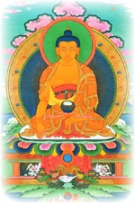
Buddha
Shakyamuni
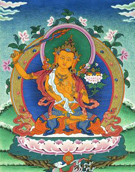
Buddha
Manjushri

Je Tsongkhapa
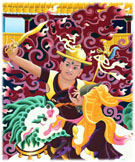 Wisdom Buddha
Wisdom Buddha
Dorje Shugden
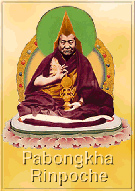
Pabongkha Rinpoche
(1878-1941)
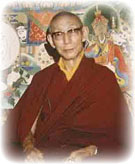
Trijang Rinpoche
(1901-1981)
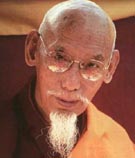
Song Rinpoche
(1904-1984)
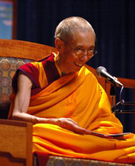
Geshe Kelsang Gyatso
(born 1931)
Chronology and background
The following are extracts from the website of The Dorje Shugden Devotee's Charitable and Religious Society in India. Their website includes documentation and witness accounts on many of the things that the Dalai Lama and his government in exile have been doing and are continuing to do to clamp down and impose the unlawful ban and force thousands of people to give up their religion - the alternative is a double tragedy, to become an outcast in their own exiled community. Their entire website can be found here:
http://www.shugdensociety.info/news.html
As these Tibetan Buddhists point out:
"The ban against the faith is shocking because Buddhism is a religion of tolerance, not dogma or force. No secular or religious-political power has the right to change the content of the doctrine. Differences in opinion are resolved with clear logic in public debates and presentation of documents which are left to the judgement and analyses of the scholars. The use of political power to impose religious opinions is unthinkable. The events since 1996 have created deep divisions, as well as conflict and suspicion, in all levels of Tibetan society: in families, monasteries, and schools."
1) The Dorje Shugden Devotee's Charitable and Religious Society
2) Chronology of events that led to the ban and outcry of lack of religious freedom
3) H.H. Dalai Lama 'bans' a deity
4) Violence, Destruction, and Death
5) Manipulation of Public Opinion
6) A Conflict with a Solution
7) Chronicle of events (Western Shugden Society)
The Dorje Shugden Devotee's Charitable and Religious Society
In April of 1996, the Dorje Shugden Devotee's Charitable and Religious Society was established. Its aim is to restore religious freedom and human rights to those who worship and rely on Dorje Shugden across the world.
Chronology of events that led to the ban and outcry of lack of religious freedom
This article is a record of events since 1970 leading to the worst dissension the Tibetan community has experienced in centuries. For the past twelve years we have been hoping for this conflict to exhaust itself. As it is lacking all historical justification and completely contradicts all Buddhist views and correct way of life, as Tibetans, we always felt embarrassed to present such a shortcoming of the Tibetan society to a large public. For this reason we have also not published an internet page until now. Unfortunately, the situation has become so bad, that we are now desperately seeking the help of every honest, unbiased, kind person of this world.
H.H. Dalai Lama 'bans' a deity
In March 1996, H.H. the Dalai Lama announced a ban against the worship of the Buddhist deity Dorje Shugden, declaring that such worship posed a "danger to his life and the cause of Tibet." The exile government then began to enforce this ban. Houses were searched and a signature campaigns were carried out. People were coerced into signing their name, agreeing to abandon all worship of this deity from then on. Those refusing to sign were openly declared enemies to the cause of Tibet and as endangering the life of the Dalai Lama. The consequences were dire for those who stood by their faith: employees of the exile government were pushed out of their jobs and children of uncompromising parents were denied school attendance. Even the constitution of the exile government was adapted to this change of policy: "The presiding judge of the Judiciary Commission ... must not be a worshipper of Gyalchen Shugden ..."
Dorje Shugden is one of many Buddhist deities which are worshipped as a protector of the teachings of Buddha. He is worshipped by many of the most venerated Masters of the Gelug and Sakya traditions of Tibetan Buddhism, as well as by many monasteries, families and entire regions. H.H. Dalai Lama himself had a close connection with this deity. His own teacher, His Holiness Trijang Rinpoche, one of the most revered Buddhist Masters of recent times, worshipped Dorje Shugden. Moreover, entire departments in the monasteries of Sera and Ganden, as well as most of the families in several regions of Tibet (like Chatring, Chamdo, etc.) have been worshipping this deity for centuries. The ban against the faith was seen as shocking because Buddhism is a religion of tolerance, not dogma or force. No secular or religious-political power has the right to change the content of the doctrine. Differences in opinion are resolved with clear logic in public debates and presentation of documents which are left to the judgement and analyses of the scholars. The use of political power to impose religious opinions is unthinkable.
The events since 1996 have created deep divisions, as well as conflict and suspicion, in all levels of Tibetan society: in families, monasteries, and schools.
Thoughtful Tibetans neither believe that the freedom of Tibet can be given by gods, nor do they believe that it can be taken away by any demons. However, when the Dalai Lama started to repeat the same slander of the deity Dorje Shugden publicly in 1996 with the harsh wording "if you want me to be damned and do not care about Tibetan freedom, then go ahead worshipping this evil spirit", then it has another impact on the Tibetan people.
Violence, Destruction, and Death
Nothing fans fanatic concern of Tibetans more violently than the thought that the Dalai Lamas' life could be in danger. The Dalai Lama, deliberately giving this as a reason for justifying the ban of Dorje Shugden, triggered within a few weeks heavy discord, fights, and destructions of holy images. The repeated pleas of concerned individuals were ignored by the office of H.H. the Dalai Lama.
Manipulation of Public Opinion
The Indian press initially reacted with critical reports regarding the new developments in the Tibetan community. From the West came concerned questions about how the actions of the exile government could be compatible with freedom of religion and democracy. The exile government soon carried out an extensive campaign to shape public opinion. These were aimed especially at Tibet support groups, Buddhist centres, and the Western media. The Indian police force was also strongly misinformed.
The original reasons that "the worship of the deity is a danger to the Dalai Lama's life and the cause of Tibet" was quickly questioned in the West. How could the worship of a deity endanger the Dalai Lama? What is the cause of Tibet? Is it a political or a religious issue?
New justifications were created which sounded more credible to western ears. Dorje Shugden was depicted as an evil spirit destroying the harmony of the Buddhist traditions of Tibet, and the ban of its worship was declared as a means for "safeguarding the profound and philosophical Tibetan Buddhism from degenerating into spirit worship". Thus the great number of Tibetan people who adhere to Dorje Shugden traditionally were declared to be a small minority and demonic sect. To the shock of many knowledgeable people, the first (and after disrobed) American Buddhist monk, who has the prestigious position of professor at the university of Columbia, even dared to label Dorje Shugden worshippers as 'Taliban' in Time magazine.
The justifications for the ban, as they are given by the Dalai Lama in the West, look reasonable at first glance. Yet, they are merely 'made up justifications', lacking real truth:
In comparison to many other religious groups and schools, the harmony between the four Tibetan Buddhist traditions is remarkably good. For example, 1500 monks from all four traditions lived together after their escape from Tibet in a place called Buxaduar in India. They lived in great harmony, like in one family - and remarkable to note: Most of the Gelug- and Sakya-monks there were Dorje Shugden practitioners. There are no inter-traditional conflicts or disputes of any kind. Disputes are primarily within one tradition, such as problems due to reincarnations, such as the two Karmapas, which has led to a division within the Karma-Kagyu. The current deity-issue created by the exile government is a dispute within the Gelug-tradition.
The second reason the Dalai Lama gives, implies the objective of reforming Tibetan Buddhism through reducing the multitude of deities. However, the reality is, that all four schools of Tibetan Buddhism recognize thousands of deities, among which hundreds are protector deities. Some of these deities originated in India, others in Tibet, and among those some are pre-Buddhist, others are of Buddhist origin. None of the Tibetan lamas, including the Dalai Lama, have any interest to reduce even one of these deities. This is particularly the case for the monasteries closely linked with the Dalai Lama, like Namgyal monastery and Nechung monastery, where more protecting deities are worshipped than in any other community, and the fervour of their deity worship is stronger than ever, well along with a number of new prayers to such gods recently composed by the Dalai Lama himself. At least four oracles are consulted regularly by the Dalai Lama and the exile government for various purposes. Such close reliance on oracles was not common even in old Tibet. Therefore, this ban has nothing to do with reforming Tibetan Buddhism, but rather with personal disfavour towards Dorje Shugden.
The fame and respect of H.H. the Dalai Lama though seemed enough to make it easy for the exile government to spread false statements. If one looks for true accounts of the history of Dorje Shugden, this can be found in many writings of important Sakya- and Gelug-masters of Tibet of the past 300 years.
However, it seems to be the policy of the exile government to stress items that cause division, rather than point to the items that would cause reconciliation.
Dorje Shugden has no rank and no position as the state deities have, and also never had any influence of this kind on any community. Therefore, Dorje Shugden always was and remains a pure protector of Dharma alone, relied upon by many great masters and their followers.
Apart from a few, misinterpreted references, there is not a single valid argument to disqualify the practice of this great Dharma protector. On the other hand, the true and clear sources affirming the extraordinary qualities of this deity are abundant among the works of earlier and later indisputable Sakya- and Gelug-masters.
A Conflict with a Solution
H.H. Dalai Lama has the tendency to trace the issue over Dorje Shugden to the 5th Dalai Lama. Fact of history is, that whatever negative circumstances have occurred at that time, they were wholesomely resolved by H.H. 5th Dalai Lama recognizing Dorje Shugden as a powerful Dharma protector. The 5th Dalai Lama then composed the first prayer dedicated to the deity and helped to found the first temple of this deity in Lhasa, called Trode Khangsar, and entrusted such monasteries as Nyanang Phelgye Ling and Chong-gye Riwo Choeling to the protection of Dorje Shugden. Still now-a-days these monasteries are housing the holy image of Dorje Shugden they received from the 5th Dalai Lama and carry on with the prayers of the deity composed by the great 5th one.
However, through those unfortunate wrong influences, the present H.H. Dalai Lama tries to give existence to a trouble, which has been nonexistent for the last 300 years. Many thoughtful observers find this most unfortunate to occur for a Tibet that is going through a most difficult time of its history and having more than enough concrete problems to be solved on a human level.
This conflict was started by the present H.H. the Dalai Lama, and it can also be ended by him at any time, if he wishes. Up until now, H.H. the Dalai Lama has done nothing to settle the dispute, instead he caused it to escalate, as if the annihilation of Dorje Shugden has become the most important objective to be pursued in his very life.
We exile Tibetans dependent on the good favour and support of the West, like many other people in the world. If the western media would therefore recognize and accurately represent the current behaviour of the Tibetan exile government, changes in this government would certainly happen, and this embarrassing situation would improve.
Political Leader
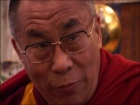 Dalai Lama
Dalai Lama
The Hypocrisy
Follow the story of the Dalai Lama's 30-year political campaign to destroy a centuries-old spiritual tradition taught to him by his own Spiritual Guide, and the efforts of those he's hurting to stop him:
Brief summary
- What is happening
- What is the Western Shugden Society (WSS)?
- Detailed reports of discrimination from inside India and elsewhere
The Dalai Lama's position
- A Great Deception
- Praise to Wisdom Buddha Dorje Shugden by the Dalai Lama
- In the Dalai Lama's words
Why is this happening?
- Why is this religious suppression taking place?
- Are the Dalai Lama's reasons valid?
Efforts to restore religious freedom
- Geshe Kelsang's open letter
- The ban is illegal and unconstitutional
- Press reports and videos
- Dorje Shugden Devotee's Charitable and Religious Society
- Dalai Lama sued for repressing religious freedom
- A conflict with a solution
- Announcement from Serpom Norling Monastery
Analysis of situation
- Sectarianism
- Can the Dalai Lama ever make a mistake?
- Is the Dalai Lama the only spiritual leader in Tibetan Buddhism?
- Theocracy or democracy?
- Spirit worship or authentic Buddhist practice?
- Freedom of worship
- The Dalai Lama's justifications
- Analysis by Dalai Lama's translator (PDF)
- What would Thomas Jefferson think of the 14th Dalai Lama?
- Book Reviews
- Videos
Evidence and first-hand accounts
- Chronological background
- Discord in exile documentary
- Political motivations for the ban
- Summary to date from Tibetan exiles
- Other
Ongoing persecution 2008-2010
- Recent vote sticks and call for help
- Forced signature and ID card campaign
- Persecution of monks at Sera Monasteries
- Public humiliation and explusion of monks
- Letter to Indian Prime Minister regarding abuses
- Letters from Dorje Shugden Devotees
- Urgent appeal from Sera Monasteries
- Support from Indian police
- Western Shugden Society letter to Sera monasteries
- Western Shugden Society letter to TGIE
- Heartfelt request from monks in Mundgod
- More discrimination planned around the world
- Letter from an FPMT monk
- Other
- What you can do